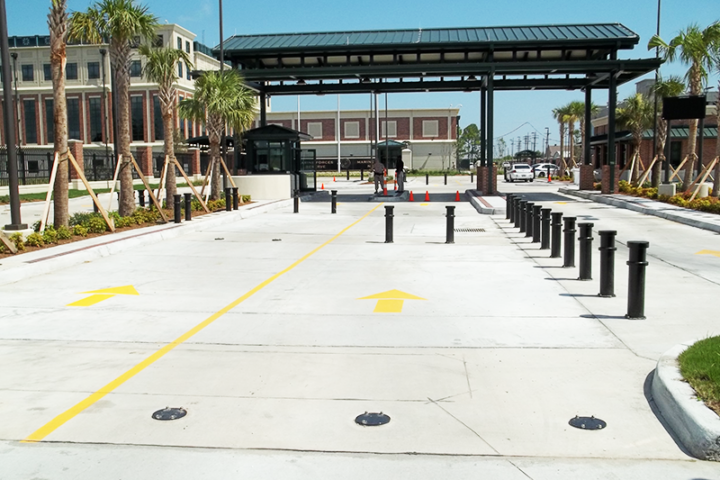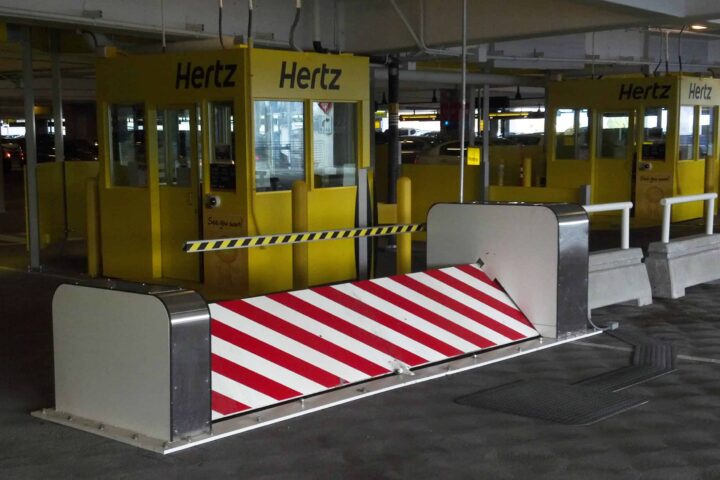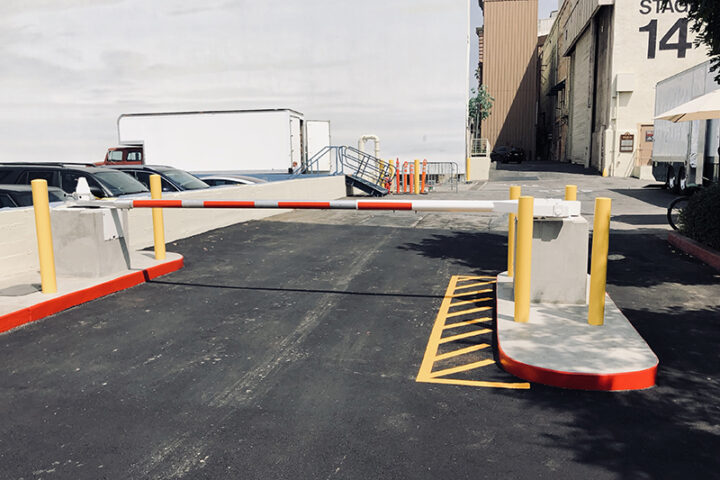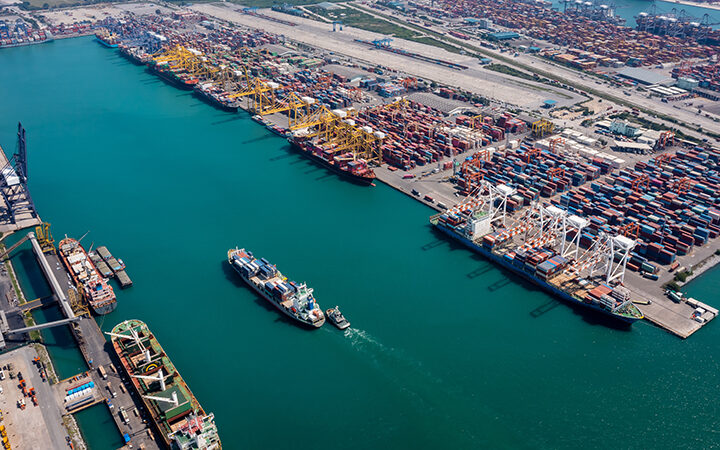How To Install a Bollard Properly
When properly installed, traffic bollards control traffic flow and keep vehicles from entering pedestrian areas or crashing into buildings. They are important safety features used in residential, commercial, military, and government settings. Knowing how to install bollards properly is critical for their effective operation.
Learn How To Install Bollards Properly
There are several ways to install bollards depending on the type of safety bollards chosen for your security needs. Some require extensive site excavation and running air, hydraulic, or electric lines. You may also need to relocate or shield existing structures and walkways.
Step 1: Project Planning and Permitting
The largest part of bollard post installation happens before you break ground. Pre-project planning should include information about all site requirements, current underground utilities or objects that could interfere with installing bollards in concrete, and the number of bollards needed to provide adequate security.
Most bollard arrays use 3-foot spacing. This meets ADA accessibility requirements for pedestrians while limiting vehicle traffic. Regulations about bollard placement vary, but they usually require you to have access available for emergency vehicles. This could mean using removable or retractable bollards near buildings or leaving a designated area with open access.
Delta Scientific staff have expert knowledge about the requirements for all of its access control systems. We can help you establish what will be necessary during the initial planning stages.
Call Before You Dig
During bollard installation planning and permitting, you will likely have to have a survey of underground utilities. This is a simple process known as “Call Before You Dig” or call 811. States have individual time requirements for this service, with most averaging about three days before work starts. Your request will prompt utility providers to mark existing underground lines, including:
Electrical wires
Gas lines
Sewer and septic pipes
Water supply lines
The next step before installing bollards is to secure the necessary permits. Contact your local building code department for requirements to ensure your installation meets current codes. Then, submit site plans and applications for permits.
Planning and permitting must be completed before construction can begin. Once underground utilities are marked and construction permits issued, site prep for installing bollards can begin.
Step 2: Site Prep for Bollard Installation
Site prep can include several steps, which vary depending on the type of bollards you are installing and the existing site conditions. Proper prep ensures a suitable site for secure installation.
Use a jackhammer or excavator to remove any concrete or pavement at the installation site. A circular saw with a masonry blade can be used to cut larger sections into more manageable pieces for removal. If you want to leave the surrounding pavement, use a core drilling rig to remove circular sections at least 2 inches wider than the diameter of your chosen bollards.
Once the surface is clear, you will need to dig the holes for the bollard base. Hand tools may suffice for smaller, fixed installations, but an excavator is recommended for large arrays or high-security bollards.
For secure installation, standard bollard foundations must reach below the frost line. Your local building department can advise you on the proper depth for your area.
Step 3: Installing Fixed Bollards in Concrete
High-security bollards have a deep, concrete foundation that extends at least 24 inches below the surface, with 48 inches offering better protection against vehicle impact. Retractable bollards must have a foundation capable of supporting their entire length.
To improve drainage conditions in the bottom of the excavated hole, use a gravel bed. Then, place a cylindrical rebar cage into the hole before pouring concrete. This reinforces the poured concrete and offers maximum protection.
Now you can place a bollard pipe within the cage and pour concrete. Be sure to choose a ready-mix blend with adequate psi for your application. Check the pipe for plumb and secure it with stakes until the concrete sets. A domed finish will help water run away from the bollard.
Installing Shallow Foundation Bollards
Shallow foundation bollards have foundations under 24 inches. These systems derive their strength from wide bases instead of deep ones. The installation steps are the same as with standard bollards, but you will need to adjust your excavation to match the wide, shallow substrate design.
They require less excavation and site prep compared to traditional models, which translates to time and cost savings. Delta Scientific offers shallow-foundation bollards with M50 crash ratings, so you can have maximum protection with a streamlined installation process.
Installing Retractable Bollards
Retractable bollards offer maximum protection in a retractable format. The bollards themselves move down into a sleeve underground when you don’t need them engaged. This requires a wide, deep foundation with a hollow center.
During installation, place the assembly within ¼ of an inch of the surrounding finished surface. During finishing, you will create a concrete berm around the receiver edge to promote water runoff.
Another consideration for retractable bollards is the power required to operate them. During excavation, power must be run to each unit and a central control panel.
Installing Portable Safety Bollards
Removeable or portable bollards bolt to a plate mounted on the surface. They offer the simplest installation process. If you have temporary needs, such as for special events, or you want to avoid the time and cost of excavation, then this is a good option. Portable bollards typically require arrays of multiple units for full crash-rated protection.
To install them, you will drill holes and insert anchors at least 4 inches into a concrete footing. Use the anchors to secure the bollard with bolts.
No matter which type of bollards you install, proper installation is necessary for them to withstand the force of impact. Incorrect installation can cause damage if a vehicle passes through or even drags the bollards behind it.
Site Safety During Bollard Installation
Safety should always be a top priority during bollard post installation. Consider the safety of yourself, the work crew, visitors, and your property when developing a work plan.
Restrict access to the construction site with appropriate signage and flagging. This will prevent pedestrians from accidentally entering the area while work is in progress. Proper PPE will also reduce the risk of injuries while operating equipment and tools for installation.
Get an Expert Perspective on How To Install Bollards
If you plan to oversee the project, you must know how to install bollards. However, you don’t need to do it yourself. When you purchase safety bollards from Delta Scientific, our team of experts will help you select the right type and install them for you. This ensures that all codes and best practices are followed. Contact us for more information.
Sources:
https://call811.com/
https://up.codes/s/bollards-around-structures
https://www.parkcity.org/Home/ShowDocument?id=63255
Choosing and Setting up Barricades for a Concert
Listening to musicians perform live and sharing the experience with others can be a special experience. However, rowdy crowds can become dangerous. Terroristic vehicle ramming attacks are unfortunately more common, and concert venues can present a soft target. We at Delta Scientific offer several barricade options to help you keep musicians and attendees safe at your next concert.
Military Base Breaches Versus Delta Scientific Barricades
Breaches of physical security on military bases by unauthorized personnel are more common than the average civilian may realize. Unauthorized personnel may wish to steal military information for a foreign power or just cause chaos by committing violence. We at Delta Scientific understand the risks that these breaches pose to national security. Our barricades have a role in preventing and thwarting such breaches.
A Guide to Anti-Ram Vehicle Barriers
Many organizations in the public and private sectors have adopted a tiered approach to physical security. Where there is a tiered approach, there are several perimeter barriers in place to prevent access by unauthorized personnel. Anti-ram barriers are examples of these perimeter barriers. If you are unfamiliar with physical security concepts, we offer this introduction to anti-ram vehicle barriers.
What Crowd Surges Are and How To Prevent Them
Major events that draw large crowds can be fun, exciting, and memorable. Unfortunately, big events can also pose their own safety risks. Event planners and venues have a duty to protect attendees from external threats and from threats caused by the crowd itself. What are crowd surges? Find out more about these unfortunate incidents and ways to prevent them.
3 Types of Traffic Barriers and When To Use Them
There are many different traffic barrier types. Some are portable, meant to keep motorists away from construction zones and other transient hazards. Others are permanent, intended primarily to protect the property itself from errant motorists. We at Delta Scientific sell products intended to protect your property from vehicles traveling at unsafe speeds or in areas they aren’t supposed to go. Here are some examples of our products and how to utilize them.
Types of Vehicle Access Control Systems
Vehicle access control systems serve to allow authorized vehicles only onto the premises by regulating their entry. They have applications for many different types of properties. If you don’t already have vehicle access control devices and are interested in purchasing some, here is a guide to the different types available from Delta Scientific. If the vehicle access control system you currently have is not effective, we offer multiple options for replacement.
Choosing From Different Types of Crowd Control Barriers
If you operate a large entertainment venue, such as a theater or a sports stadium, or you hold a large event on a regular basis, you need crowd control barriers to avoid trouble. There are barriers that go both inside and outside. We at Delta Scientific primarily offer vehicle access control barriers for use outside your venue.
The Importance of Port Security Barriers
Every year, billions of dollars in valuable cargo is shipped around the world and passes through ports by the ton. In addition, millions of people travel around the world by sea and by air every year. Port security is a collaborative effort by organizations around the world to safeguard the ports, the people and cargo traveling through them, and the countries in which the ports are located from various potential threats. We at Delta Scientific offer several products with applications for port security.










